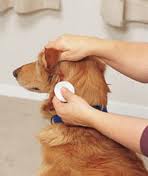Because dogs are covered in fur, many dog owners do not think about their dogs getting skin cancer. However, of all the types of tumors found in dogs, skin tumors are the most common. Early diagnosis and treatment are critical in fully removing the tumors.
Exposure to the sun is the most common cause of dog skin cancer. Dogs with light-colored fur are prone to skin cancer, as are older dogs and unneutered male dogs.
Symptoms
The symptoms of dog skin cancer include vomiting, coughing, diarrhea, loss of appetite, wounds that heal slowly and swollen lymph nodes. In more severe cases, the dog may have an abnormal heart rhythm, changes in blood pressure, difficulty breathing, black feces, itchiness and bleeding disorders.
What to look for
There are several physical signs that dog owners should look for to determine if their dogs have skin cancer. They include the following:
- Color changes on skin
- New growths or sudden increase in size of growths
- Crusty areas on skin
- Nipple discharge
- Excessive scratching and licking in a certain area
- Bleeding growths
Types of dog skin cancer
Dog skin cancer can come in various forms, including the following:
- Malignant melanoma – These cancerous tumors occur primarily in the mouth and mucus membranes. They spread quickly and are often caused by genes or trauma.
- Mast cell tumors – These tumors are the most common in dogs. They form in the immune system. It is unknown why they occur, but it is suspected that genes, hormones and skin irritants all play a role.
- Squamous cell carcinoma – This type of cancer occurs in the outermost layers of skin. It is commonly caused by exposure to the sun. Although squamous cell carcinoma does not affect lymph nodes, it is aggressive and destructive.
- Papillomas – These are wart-like growths that resemble cauliflowers in appearance. They can grow just one at a time or in groups. They commonly grow in the mouth and on the feet, head and eyelids. Surgery is often required to remove them.
- Basal cell tumors – These are one of the most harmless types of tumors, as they are always benign. They grow deep down inside the skin. They are commonly found in the shoulders, head and neck of older dogs. They must be removed surgically.
Diagnosis
 In order to positively identify the growth as a tumor, the vet will need to take a biopsy of the growth and have it analyzed. Blood tests will be performed and may include a complete blood count (CBC). A urinalysis, ultrasound and X-rays may be performed. Biopsies may also be done on bone marrow and lymph nodes.
In order to positively identify the growth as a tumor, the vet will need to take a biopsy of the growth and have it analyzed. Blood tests will be performed and may include a complete blood count (CBC). A urinalysis, ultrasound and X-rays may be performed. Biopsies may also be done on bone marrow and lymph nodes.
A pathologist will study the samples and determine the grade of the tumor. Most are Grade 1, which means that they are easily treated. Grade 2 tumors are moderately difficult to treat and have a fair prognosis. Grade 3 tumors are the least common, but they are also the most aggressive. They spread quickly and have a poor prognosis.
The pathologist will also determine the stage of the tumor. The stage refers to how quickly it is growing. Stage 1 refers to a tumor that has little chance of spreading. Stage 2 and 3 tumors have already spread to nearby areas. There may also be multiple tumors at these stages. Stage 4 refers to a full-blown tumor with little chance of a full recovery in the dog.
Treatment
There are several main forms of treatment used, based on the size and type of tumor. Surgery is the most effective treatment. It can be used to remove tumors that have not yet spread. Radiation may be used to reduce the size of the tumor. Chemotherapy is used for tumors that have spread. Cryosurgery involves freezing the tumor and surrounding areas. This is best done on smaller tumors.
Huffington Post has an informative article about dog skin cancer, as well as a video to accompany it here.

Leave a Reply